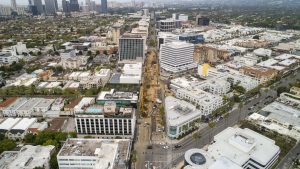 California’s rail and bus investment projects have received USD 500 million from the California State Transportation Agency (CalSTA). 17 transport operators will benefit the new funding by implementing the projects which have a total cost of USD 5.44 billion. The funding for the projects will be provided for the design and construction, and is complemented by investments of federal, local and other state funds. In total, California’s rail and bus investment projects leverage more than USD 4.9 billion in additional investment.
California’s rail and bus investment projects have received USD 500 million from the California State Transportation Agency (CalSTA). 17 transport operators will benefit the new funding by implementing the projects which have a total cost of USD 5.44 billion. The funding for the projects will be provided for the design and construction, and is complemented by investments of federal, local and other state funds. In total, California’s rail and bus investment projects leverage more than USD 4.9 billion in additional investment.
“The USD 500 million in grant awards will increase transit service on new and existing routes, provide for a more integrated transit system, reduce greenhouse gas emissions, and support jobs. Although the current COVID-19 pandemic is putting tremendous stress on transit agencies, these funds support long-term capital projects to be completed in the years to come and will help support the economic recovery in the years ahead,” said David Kim, the Secretary of the Agency.
Bay Area Rapid Transit (BART) has received USD 107 million grant for the procurement of 34 trains (306 cars) to support the completion of the Core Capacity Programme. USD 3.5 billion is the total value of the project.
Capitol Corridor Joint Powers Authority received USD 3.9 million for the construction of a new northside station access route to connect the Sacramento Valley station to the future Railyards Plaza where 10,000 housing units are planned. This includes LRT and bus services improvement, as well as other integration projects and studies. USD 6 million is the total cost of the proposed project.
USD 95.2 million was awarded to the City of Inglewood for the construction of a 2.6 km automated people mover (APM) system and three new stations in the city. The project will create a new connection between the City of Inglewood’s high growth areas with LA Metro’s regional rail system. The total cost of the project exceeds USD 1 billion.
LA Metro was awarded a USD 107 million grant for a USD 220.8 million project which envisages the increase of infrastructure capacity and services as well as the assessment of a feasibility of rail multiple unit and zero-emission propulsion service through a pilot project on the Metrolink Antelope Valley Line (AVL). These subprojects will allow regular services between Los Angeles Union Station and Santa Clarita.
USD 38.7 million funding will support a USD 87.2 million project carried out by Los Angeles-San Diego-San Luis Obispo Rail Corridor Agency (LOSSAN) which envisages the expansion and improvement of rail passenger service in southern California. The grant includes funding to construct a Central Coast layover facility in San Luis Obispo, to design and construct a new maintenance and layover facility in San Diego that will allow overnight storage and servicing of Pacific Surfliner equipment to be relocated from the Santa Fe Depot to a new location in National City, and also to help overhaul and modernize the Pacific Surfliner railcars.
USD 23.6 million funding will allow the implementation of a USD 47.2 million project which is carried out by the Sacramento Regional Transit District. The project consists of the procurement of 8 new low-floor LRVs for the Gold Line, linking Sacramento Valley and Historic Folsom stations.
San Diego Association of Governments (SANDAG) will implement a USD 36 million improvement programme that was awarded a USD 12.1 million support. The project will see additional track construction along a 1.6 km section in El Cajon, to allow Green and Orange lines to terminate at the El Cajon transit centre.
The USD 87 million core capacity project of San Francisco Municipal Transportation Agency (SFMTA) has received USD 41.7 million grant. The project will increase bus and rail capacity under the Muni Forward corridor programme.
Along these projects, the transport agency awarded funding for bus projects comprising vehicle procurement, increase capacity programmes and infrastructure development.
Share on:



